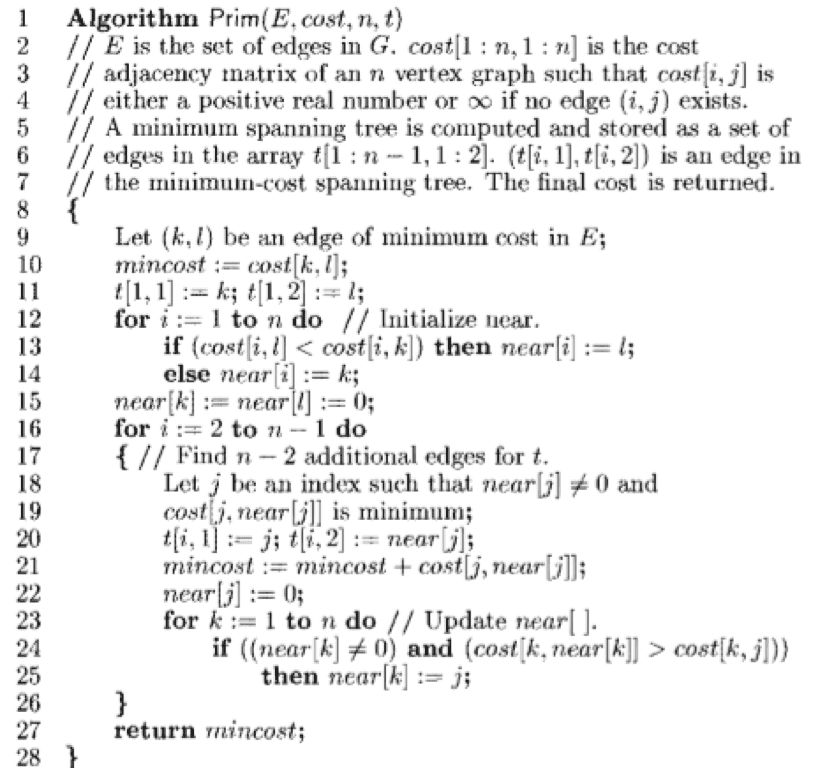02 Greedy
A greedy algorithm solves problems by making the choice that appear to be the best at that particular moment.
Prim’s Algorithm¶
Refer Discrete Structures
- With cost matrix \(O(n^2)\)
- With heaps \(O\Bigg( (n + |E|) \log n \Bigg)\)
I didn’t understand the code implementation

Knapsack Problem¶
There exists items, with each having
- profit \(p_i\)
- weight \(w_i\)
There also exists a limit \(m\) which is the max weight you can pick
Goal¶
maximize profit \(P\), while adhering to the limit.
\[ \begin{aligned} \text{max } P = & \sum p_i x_i \\ \text{such that} & \sum w_i x_i \le m \end{aligned} \]
Steps¶
- Convert list of \(p_i\) and \(w_i\) into a new list of \(p_i/w_i\)
- Sort in descending order
Algorithm¶
// this is for x_i = 0 or 1 (binary)
Algorithm GreedyKnapsack(p, w, m, n)
{
Input
- Profit array (sorted)
- Weights array (sorted)
- max capacity (knapsack size)
- no of objects
for i=1 to n
x[i] = 0
remaining_cap = m
for i=1 to n
if(w[i] < remaining_cap)
x[i] = 1
remaining_cap -= w[i]
else
break
if (i<=n)
x[i] = remaining_cap/w[i]
}
Types¶
| Type | Example | |
|---|---|---|
| 0/1 (Discrete) | An item can be - not taken - completely taken | Phone |
| Fractional (Continous) | An item is can be - not taken - partially taken - completely taken | Juice |
Tree Vertex Splitting¶
Directed and weighted binary tree
Steps¶
- Traverse from bottom
- Split a node from the tree if \(d(u) > \delta\)
- \(d(u) = 0\) for leaves
- \(d(u) = \underset{v \in c(u)}{\max} \{ d(v) + w(u, v) \}\)
- Traverse upward
Example with \(\delta=5\)¶
flowchart TB
subgraph After
direction TB
a1((1)) --> a2((2i)) & a3((3))
a2o((2o)) --> a4i((4i))
a4o((4o)) --> a7((7)) & a8((8))
a3 --> a5((5)) & a6i((6i))
a6o((6o)) --> a9((9)) & a10((10))
end
subgraph Before
direction TB
1((1))
2((2))
3((3))
4((4))
5((5))
6((6))
7((7))
8((8))
9((9))
10((10))
1 -->|4| 2
2 --> 0(( ))
2 -->|2| 4
4 -->|1| 7
4 -->|4| 8
1 -->|2| 3
3 -->|1| 5
3 -->|3| 6
6 -->|2| 9
6 -->|3| 10
endAlgorithm TVS(T, w, delta)
{
if(T != 0)
{
d[T] = 0
for each child v of T
{
TVS(v, w, delta)
d[T] = argmax{d[T], d[v] + w(T, v)}
}
if(
T is not root
and
d[T] + w(parent(T), T) > delta
)
{
write(T)
d[T] = 0
}
}
}
Job Scheduling¶
Similar to Knapsack problem
There exists jobs, with each having
- profit \(p_i\)
- deadline \(w_i\)
To complete each job, it only takes 1 unit of time
Also
- it is not necessary to complete all jobs
- a job can only be taken once
Goal¶
maximize profit \(P\), while adhering to the limit. $$ \begin{aligned} \text{max } P = &\sum p_i x_i \ \text{such that } & d_i \text{ is not violated} \end{aligned} $$
Step¶
- Sort the jobs in descending order based on profit
Algorithm¶
Algo JS(arr, t):
// length of array
n = len(arr)
sort_desc(arr)
// To keep track of free time slots
result = [False] * t
// To store result (Sequence of jobs)
job = ['-1'] * t
// Iterate through all given jobs
for i in range(len(arr)):
// Find a free slot for this job
// (Note that we start from last possible slot)
for j in range(min(t-1, arr[i][1] - 1), -1, -1):
// Free slot found
if result[j] is False:
result[j] = True
job[j] = arr[i][0]
break
// print the sequence
print(job)